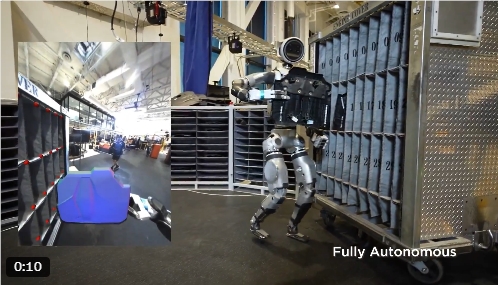Boston Dynamics released the latest demo video of its humanoid robot Atlas, demonstrating its ability to autonomously carry engine parts in a factory environment. This marks a significant progress in Atlas's autonomous operation, with all actions being done autonomously rather than preset programs or remote controls, which is in stark contrast to some misleading demonstrations in the industry. In the video, Atlas demonstrates its powerful adaptability and flexible motion control. For example, the flexible rotation of its waist can not only show strong driving performance, but also effectively save operating time. The release comes two weeks after the cooperation agreement between Boston Dynamics and Toyota Research Institute was reached. The cooperation between the two parties will further improve Atlas' performance.
In the latest video released on Wednesday, Atlas was shown to independently complete the handling of engine parts in the demonstration area. Boston Dynamics particularly emphasizes that all actions of the robot are completed independently, rather than preset programs or remote control. This statement seems to imply some practices in the industry that publish misleading demonstration videos to gain attention.

The timing of the video is worth paying attention to, two weeks after the company reached an important cooperation agreement with Toyota Research Institute (TRI). While it is not clear how much of the content in this three-minute video is the result of the collaboration, TRI's technological advantages in robot learning and real-time adaptation will undoubtedly bring important improvements to Atlas.
According to Boston Dynamics, Atlas is equipped with a variety of sensors such as vision, force sensing and proprioception, which can effectively detect and respond to environmental changes, such as moving objects, installation failures, tripping risks and environmental collisions. The robot also demonstrates impressive adaptability, especially the flexible rotation of its waist, which not only demonstrates powerful driving performance but also effectively saves operating time.
Similar to competitors such as Figure, Tesla and Apptronik, Boston Dynamics has also positioned the first application scenario of this bipedal robot at an automobile manufacturing plant. This choice is quite strategic: not only because Boston Dynamics is now a subsidiary of Hyundai Motor, but also cooperates with Toyota Research Institute, but more importantly, the automotive industry has always been in the leading position in the field of automation.
This demonstration not only demonstrates the important progress of Atlas in autonomous tasks, but also highlights its huge potential in industrial applications, marking an important step forward for humanoid robots to practical application scenarios.
Atlas' successful demonstration heralds the coming of widespread use of humanoid robots in the industrial field, and its autonomy and adaptability will greatly improve productivity and safety. Boston Dynamics' continuous innovation and breakthroughs in the field of humanoid robots provide new possibilities for future intelligent manufacturing. In the future, we can look forward to the application of Atlas in more industrial scenarios and its continuous technological progress.